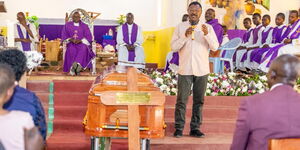The High Court in Nairobi has delivered a landmark ruling, ordering the government to compensate over Ksh470 million to the families of Garissa University students who were killed or injured in the 2015 terror attack.
The judgment was handed down on Wednesday, July 31, by Justices Antony Ndung'u, Mugure Thande, and Daniel Kemei. The court found the state negligent in its duty to protect the students.
The judges awarded the families of the 148 students who lost their lives during the 2015 Garissa University attack Ksh3 million each.
For the 14 survivors who were injured and filed the case in court alongside Kituo Cha Sheria, the court granted varying compensation amounts based on the severity of their injuries. One individual, for instance, was awarded Ksh10 million.
The ruling follows a lawsuit filed by survivors of the April 2, 2015, attack, alongside families of the victims, who argued that the government had prior intelligence about the impending assault but failed to act. The plaintiffs accused the state of ignoring actionable information that could have prevented the massacre, which left 147 students dead and many others injured.
The court papers revealed that the government had sufficient intelligence and general information about the attack but neglected to implement preventive measures or facilitate an effective rescue operation.
"There was sufficient intelligence and general information on the attack but the Respondents deliberately failed and neglected to carry out the necessary preventive measures, mitigate the effects and ease the escape and rescue during the attack," stated the former students in their testimony.
Kituo Cha Sheria, an organisation advocating for the victims, emphasised that the security agencies and the university administration failed to act on the available intelligence, thus exacerbating the tragedy. The survivors and their families have sought compensation for the psychological trauma and medical expenses they have endured since the attack.
One of the most damning aspects of the case involved the delayed deployment of the Recce Squad, an elite unit of the General Service Unit (GSU).
The court documents highlighted that the Recce Squad arrived at the scene 12 hours after the attack had begun. The siege, which started in the early hours, continued until approximately 6:20 pm.
This delay was attributed to the misuse of state resources, as an officer under the National Police Service had allowed the pilot of the police aeroplane to use it for personal reasons, transporting family members from Mombasa to Nairobi, instead of ferrying the elite squad to Garissa.
The petitioners also criticised the unlawful deployment of the army, which led to uncoordinated efforts and further loss of life. The court recognised these failures and ruled that the government must be held accountable for the security lapses and the resultant consequences.
Despite the government's defence that there was no specific and actionable intelligence about the attack, the court found overwhelming evidence to the contrary.
It remains unclear whether the government, through the office of the Attorney General, will appeal the ruling.












